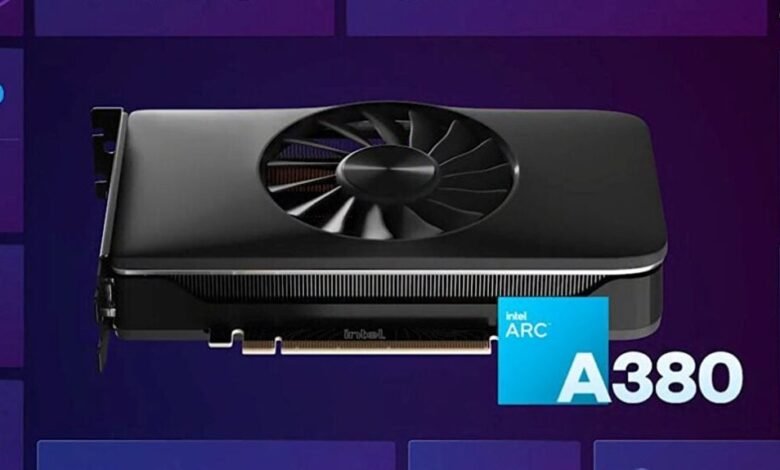
Enterprise computing requires ever-more-powerful hardware solutions to handle demanding workloads and guarantee flawless user experiences. GPUs—graphics processing units—are essential to this endeavor because they provide faster performance for tasks like intricate data analysis, video editing, and 3D design.
The question arises as to whether Intel’s recent entry into the discrete GPU market will have a major impact on the enterprise landscape.
This article explores Intel Arc’s enterprise potential, including its technical details, salient features, and possible advantages for companies looking to boost performance and productivity.
Intel Arc: A Novel Entrant in the Field of Understanding
With the release of Intel Arc, Intel has entered the previously held market share by Nvidia and AMD for discrete GPUs. It was introduced at the beginning of 2023 and provides a selection of graphics cards (A380, A580, A750, and A770) to suit various performance levels.
These cards are based on the Xe architecture and come equipped with cutting-edge features like AI acceleration capabilities, XeSS upscaling, and the Xe HPG microarchitecture.
How does Intel Arc work?
The Intel Arc line of discrete GPUs is intended for use in a variety of computing applications, such as workstations, laptops, and desktops. The original lineup consists of the high-performance Arc A7xx and A9xx series for demanding workloads, the mainstream and mid-range Arc A5xx and A7xx series, and the entry-level Arc A3xx series.
Important Features of the Business
- Software Ecosystem: Intel is working hard to create an ecosystem of software that includes enterprise application-specific drivers, SDKs, and optimization tools. This guarantees performance optimization and compatibility with a range of professional software.
- Management and Monitoring: Intel provides tools that make it easier to deploy and maintain Arc GPUs within an organization’s IT infrastructure by centralizing management and monitoring.
- Xe Architecture: The Xe architecture, upon which Intel Arc GPUs are based, includes hardware specifically designed for media encoding/decoding, AI acceleration, and ray tracing. For particular workloads, these features can greatly increase performance and efficiency.
- Security: Intel Arc GPUs are equipped with hardware-based security features such as Intel SGX and Intel VT-d, which improve system integrity and data protection, which are important factors to take into account in enterprise settings.
Benefits of Intel Arc for Enterprises
1: Enhancing Ownership Total Cost
When installing new technological solutions, organizations must examine not only performance and capabilities but also the total cost of ownership (TCO). In this context, Intel Arc provides compelling value propositions that can assist enterprises in meeting their business objectives and increasing return on investment.
One of Intel Arc’s primary advantages is its energy efficiency, which is achieved through superior semiconductor manufacturing techniques and power management technology.
Intel Arc enables organizations to cut energy consumption, operational expenses, and environmental footprint without losing performance or reliability, as it delivers more performance per watt than prior generations of GPUs.
2: Intel Arc: Increasing Productivity
In today’s fast-paced corporate world, efficiency is essential, and every moment counts. Intel Arc is designed to boost productivity by boosting graphics-intensive operations and shortening time-to-complete for key jobs.
Whether generating complex 3D models, editing high-resolution films, or analyzing big datasets, Intel Arc GPUs enable users to work more efficiently and effectively. It allows them to focus on innovation and creativity without being constrained by performance bottlenecks.
One of Intel Arc’s main advantages is its ability to use hardware-accelerated graphics processing to accelerate compute-intensive workloads.
By shifting graphics processing workloads from the CPU to the GPU, Intel Arc allows for faster rendering speeds, better multitasking, and improved responsiveness across a wide range of applications.
This not only increases user productivity but also allows enterprises to optimise resource use and maximise the value of their computing infrastructure.
3: Handling Compliance and Security Needs
Data protection and privacy are important issues in today’s cybersecurity scenario for enterprises. As businesses rely more on graphics-intensive applications to foster innovation and collaboration, it’s critical to keep sensitive data secure and in line with industry rules and best practices.
Intel Arc includes advanced security features and technologies that are designed to protect sensitive data and reduce security risks in enterprise situations.
Intel Arc offers a complete security framework that assists organizations in protecting their assets and meeting regulatory standards, from hardware-based encryption and secure boot mechanisms to robust access controls and threat detection capabilities.
Read Also: Speed Demons Rejoice: i9 Core Laptop for Unthrottled Power
4: Opening Up New Visual Computing Possibilities
Apart from enhancing efficiency, Intel Arc creates new opportunities for visual computing, enabling companies to create engaging experiences and offer engaging material to stakeholders and customers.
Whether you’re creating interactive presentations, virtual prototypes, or augmented reality applications, Intel Arc has the graphical capability you need to bring ideas to life and captivate audiences.
One area in which Intel Arc excels is real-time visualization and simulation, where the ability to render high-fidelity visuals at fast frame rates is critical for generating immersive experiences.
From architectural renderings and product prototypes to scientific simulations and virtual training environments, Intel Arc enables businesses to push the limits of what’s possible and generate visually spectacular content that captivates and inspires.
Goal Uses for Organizational Efficiency
- Analytics Professionals and Data Scientists: AI-powered machine learning and data analytics workloads can leverage Intel Arc’s AI acceleration features to produce insights faster.
- Entertainment and Media: Intel Arc GPUs’ hardware-accelerated media processing capabilities are advantageous for tasks involving the creation, editing, and transcoding of content.
- Cloud computing and virtualization: By deploying Intel Arc GPUs in cloud platforms and virtualized environments, demanding graphics applications can be accessed remotely.
- Engineers and Designers: CAD software, simulations, and 3D rendering can all be accelerated with Intel Arc GPUs, leading to more efficient design processes and shorter product development cycles.
Final Thoughts: Leveraging Intel Arc’s Power in the Enterprise
The incorporation of Intel Arc into computing environments presents an attractive prospect for increasing productivity. It expands the potential of visual computing and optimizes the total cost of ownership, particularly as enterprises persist in their embracement of digital transformation
With its scalable performance, energy-efficient design, and advanced security features, Intel Arc is poised to redefine the way enterprises approach graphics-intensive computing and unlock new opportunities for growth and success.
By leveraging the power of Intel Arc, businesses can empower their employees to work more efficiently, create more compelling content, and stay ahead of the curve in today’s dynamic and competitive business landscape.
Read Also: Best Jobs with Artificial Intelligence Training?



